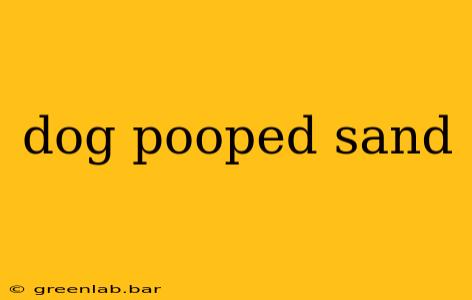Has your dog been leaving behind…sand? Instead of the usual dog doo, you're finding piles of what looks suspiciously like sand mixed with feces. This isn't normal, and it warrants investigation. This article will explore the potential causes of sandy dog poop, offering advice on diagnosis and treatment. Understanding this issue is crucial for ensuring your canine companion's health and well-being.
Why is My Dog Pooping Sand?
Several factors can contribute to your dog excreting sand-like feces. Let's examine the most likely culprits:
1. Dietary Factors:
- Sand Ingestion: Dogs, especially playful ones, might accidentally ingest sand while playing on beaches, in sandboxes, or even during walks on sandy trails. This sand passes through their digestive system and mixes with their stool, resulting in a sandy consistency.
- Dehydration: Dehydration can lead to harder, more compacted stools. If your dog isn't drinking enough water, the feces might appear drier and grittier, potentially mimicking the texture of sand. Observe your dog's water intake—is it sufficient for their size and activity level?
- Dietary Changes: A sudden shift in diet can upset your dog's digestive system. Introducing new foods or treats too quickly can cause diarrhea or constipation, altering the stool's consistency. Consider if you've recently made any changes to your dog's food.
2. Medical Conditions:
- Gastrointestinal Issues: Various gastrointestinal conditions can cause changes in stool consistency. These include inflammatory bowel disease (IBD), parasites, and bacterial infections. Sandy stool could be a symptom of underlying inflammation or infection.
- Pancreatitis: Problems with the pancreas can affect nutrient absorption, leading to changes in stool quality. This is a serious condition that requires veterinary attention.
- Malabsorption Syndromes: These syndromes hinder the proper absorption of nutrients, potentially resulting in altered bowel movements.
3. Parasites:
- Internal Parasites: Intestinal parasites like hookworms, roundworms, or whipworms can cause diarrhea, weight loss, and changes in stool consistency. A sandy texture could be indicative of a parasitic infection.
What to Do If Your Dog is Pooping Sand
If you notice your dog consistently pooping sand-like feces, don't delay in seeking veterinary attention. Here's a step-by-step approach:
- Schedule a Veterinary Visit: A thorough examination by a veterinarian is essential to rule out underlying medical conditions. They can perform tests, such as fecal examinations, to determine the cause.
- Detailed History: Be prepared to provide your veterinarian with a detailed history of your dog's diet, behavior, and any recent changes. Mentioning sand ingestion or dietary shifts can be helpful.
- Monitor Water Intake: Ensure your dog is adequately hydrated. Increase water access and observe their drinking habits.
- Dietary Adjustments (under veterinary guidance): Your veterinarian might recommend dietary changes to improve digestion and stool quality. Avoid making significant changes without professional advice.
Prevention is Key
While accidental sand ingestion is difficult to entirely prevent, you can minimize the risk:
- Supervise playtime: Keep a close eye on your dog, especially when playing in sandy areas.
- Rinse off after playtime: Thoroughly rinse your dog after playing in sand to remove any sand clinging to their fur.
- Maintain a consistent diet: Avoid sudden changes in your dog's diet.
- Regular veterinary check-ups: Routine check-ups allow for early detection of potential health problems.
Remember, observing your dog's stool consistency is an important part of responsible pet ownership. Addressing the issue of sandy feces promptly can prevent more serious health complications. Always consult your veterinarian for proper diagnosis and treatment.

